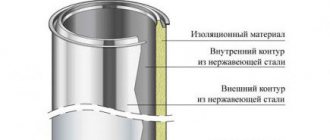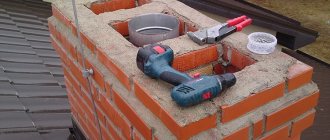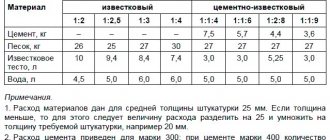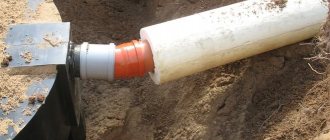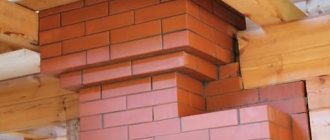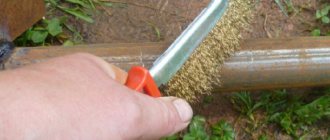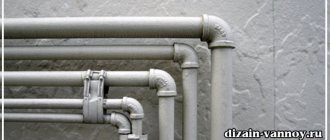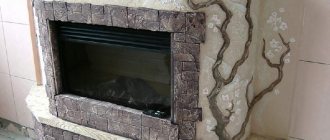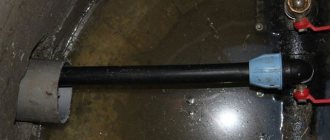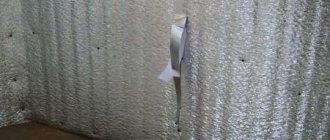When building a private home and installing a heating system, many homeowners are faced with the difficulty of laying a chimney. Quite often, red ceramic bricks are used for this work, which must be laid using a special oven mortar. We will talk about how to choose the composition used for laying the chimney in this article.
Many homeowners mistakenly believe that for laying a chimney they can use ordinary cement mortar, which was used for laying brick walls. However, experts do not recommend using it when laying a stove and chimney. The fact is that during operation the chimney is subjected to significant thermal and chemical loads, and a conventional binder mixture cannot be used in this case. It is necessary to use special thermoeffective mixtures that can withstand increased thermal loads with equal ease and are resistant to various acids .
For laying the stove pipe, it is recommended to use compositions that are normal in terms of fat content, since they are characterized by proper plasticity and are not prone to cracks. For this work, complex compositions are used, consisting of several components. Binders based on sand, cement and lime are very popular. Also on sale you can find ready-made mixtures intended for bricklaying, characterized by excellent heat resistance.
The only drawback of such dry mixtures for masonry is that they are expensive. Therefore, many homeowners, when engaged in such construction work, prepare the solution themselves.
You should also pay attention to the density of the composition used. The prepared mixture should be homogeneous and vaguely resemble sour cream in structure. It should be slightly squeezed out when laying bricks, but should perfectly hold together the materials used. The following compounds are used for this work:
- Clay.
- Calcareous.
- Cement with the addition of lime and chamotte.
- Lime-gypsum.
Clay mortars for masonry
High-quality clay compositions with the addition of cement and sand were successfully used for chimney laying in the past, but today they are gradually being replaced by other, high-quality and
inexpensive preparations. The clay-based composition is resistant to high temperatures, but it can be destroyed when exposed to moisture. That is why it is necessary to install a large metal umbrella over the stove pipe, which will completely prevent water from getting inside the stove. When using clay mortar for laying a brick stove and chimney pipe, you must remember that using wet, fresh firewood as fuel in this case is not recommended. This will also lead to failure of the chimney.
To increase the strength indicators when preparing clay mortar, you can add about one hundred grams of table salt per kilogram of Portland cement. Just remember that salt must be mixed with water an hour before cooking. To check the quality of the prepared mortar for the brickwork of the chimney, it is necessary to mold a small ball with a diameter of about 50 millimeters from the resulting mass. The resulting ball should hold its shape perfectly and not stick to your hands. Subsequently, the laying of the chimney using a clay composition is carried out according to the standard scheme.
The use of mortars for laying brick chimneys
Lime composition is used for laying the furnace pipe. A mixture of water and lime with the addition of sand is prepared. The mortar prepared according to the rules can withstand high temperatures, is resistant to moisture and ensures the reliability and durability of the oven, connecting the bricks with high quality. To create a more durable mixture, cement is added, and gypsum is added to speed up hardening during putty work.
The clay composition is not suitable for laying a chimney, as it does not withstand moisture, which leads to the formation of cracks. But at the same time it is resistant to temperature increases, therefore it is used as a mixture for the main part of the furnace structure. However, such a solution should not differ from the composition of the brick, be durable and not emit fumes. To increase strength, add 100-200 grams of salt an hour before mixing. The masonry is made on the basis of fire-resistant clay and fireclay bricks. The cement mixture is used to build pipes. It sets quickly, so it is necessary to work with it within an hour after mixing, otherwise the solution will begin to lose strength. After laying, the solution is covered with shavings and moistened with water for 4-5 days.
Lime mortar for stove pipe
Lime mortars for laying stove pipes began to be used relatively recently and today they have become the main masonry material. When properly prepared, it provides excellent heat resistance, is not affected by moisture and holds the masonry together efficiently, ensuring maximum durability of the entire structure. To improve the quality of lime mortar, it is recommended to use slaked lime, sand, a small amount of cement and gypsum. The classic recipe for brickwork involves one mass fraction of lime and five parts sand. Lime and cement are added in minimal volumetric quantities. You also need to add water and stir everything until smooth. The solution should have the consistency of thick sour cream and not stick to the trowel and concrete mixer.
When using such a solution intended for laying a stove pipe, you should remember that its quality directly depends on the quality of the lime.
That is why it is recommended to use boiling lime, which is filled with water and then left until it is completely quenched. It is best to carry out the lime slaking procedure in plastic barrels or pre-dug holes lined with boards. Only after this can you begin to prepare the composition necessary for brickwork.
How to prepare clay mixtures for stove masonry
The mixture is used for construction inside the building. It cannot be used for chimneys on the roof. The optimal proportions are considered to be: the ratio of the shares of clay and sand as 1:1 or 1:2, and the volume of water as 1:4. In practice, everything is determined by the fat content of the clay.
One of the tests is used to check raw materials. For example: a kind of dough is kneaded from 500 g of clay and balls with a radius of 20–25 mm are rolled. The ball is placed between two dies and squeezed until cracks appear on the lump of clay. A ball of thin clay falls apart even with slight pressure. From poor - when the volume is reduced by ¼ or 1/5. Normal cracks appear when reduced to 1/3 of the diameter, and oily – when reduced to ½.
The best is normal clay. When using it there is no need to add sand. If it is oily, then carefully sifted river sand is added in a proportion of 0.5 to 5 volume fractions. The result will be checked using the test described above. If it’s poor, they wash it out: fill it with water and wash out the excess sand.
To obtain the solution with your own hands, take the following steps.
- The clay is laid on a flooring made of boards measuring 1.5 * 1.5 m. It must be applied in layers and moistened with water.
- If you need to add sand, it is laid in a layer on top of the moistened clay.
- As soon as the clay gets wet, it is mixed and raked into a ridge about 30 cm high. Then the ridge is chopped with the edge of a shovel into plates, the edges and lumps are crushed. Then they are collected again into a ridge.
- Stirring is repeated 3–5 times until there are no clots left in the resulting mixture. The finished solution slides off the iron shovel, but does not spread. A sample can be seen in the presented photo.
Cement based mortar
Cement-based mortar is characterized by increased strength and ease of preparation. Cement-based brickwork is strong, durable and resistant to soot and other aggressive substances. Today, cement-based masonry mortar, due to the affordable cost of the components used and ease of preparation, is most widespread.
The composition for the chimney above the roof is made of cement, sand and the addition of water. The ratio of cement and sand can vary from one to one to one to six. It should be remembered that such a solution sets quickly, and an hour after preparation it begins to lose its strength and elasticity. Therefore, you should not prepare it in large batches, but use it immediately after preparation within 30 – 60 minutes.
High-quality preparation of cement mortar
We pour the used cement and sand through a sieve to completely get rid of lumps. Mix sand and cement until a homogeneous mass is obtained. At the final stage of cooking, add water to obtain the desired consistency. Just remember that such a solution based on cement and sand alone does not have proper heat resistance, so it is not recommended to use it for laying a chimney in the immediate vicinity of the stove.
If you need to prepare a heat-resistant solution, then you will need slaked lime, which is diluted with sand in a one-to-one ratio. Next, 0.5 parts of cement are added and everything is thoroughly mixed. A properly prepared solution of lime and cement has excellent thermal stability, which allows it to be used for laying the lower part of a brick pipe. Also, to increase the strength of the material, fireclay can be used, which improves the thermal strength of the composition.
When using cement to prepare mortar, it is recommended to use a material with a strength index of at least M400. This will ensure the necessary strength of the brickwork and its durability. The thickness of the seam can vary from five to ten millimeters.
Checking the clay before preparing the solution
With the usual fat content of the solution, the trowel is removed from the batch clean or almost clean.
To make a clay solution correctly, you need to check the clay: add not very much water to a fraction of a kilogram and knead it well with your hands until it completely absorbs the water and begins to stick to your hands. After making the hard dough, create a ball with a diameter of 40-50 mm, and from another of the same ball, flatten a cake with a diameter of 100 mm and dry both products for 2-3 days. If after this time cracks appear on the cake or on the ball, it means that the clay is too oily and you need to add sand to it. And if there are no cracks on the ball and cake after it dries and they can withstand a fall from a height of 1 m, it means that the clay can be used in preparing a solution. Frail clays do not crack, but they are not strong, and therefore they must be mixed with fatter clays. Clay or sand is added in a couple of steps until the solution is ready.
To make a solution, use various clays, mixing them dry and then mixing them with water. Add 0.5-5 parts volume of sand to the fatty clay. It must be sifted through a fine sieve with holes of 1.5×1.5 mm. Very frail clay is washed out - the remaining sand is removed from it, washed with water.
Lime-gypsum mortar
Inexpensive to produce, lime gypsum mortar is actively used in finishing and plastering stoves. When cement and a large amount of lime are added to it, this composition can easily be used for laying a brick chimney pipe. The advantage of using it is the ease of working with it and faster setting. You just need to correctly calculate the ratio of components and achieve the desired consistency of the prepared mass.
Before firing the stove for the first time, you need to thoroughly dry the masonry, which will eliminate the danger of cracking the chimney.
Types of solutions
All types of chimney mortars consist of binders, filler and solvent. The first two components work in “close interaction”:
- The binder, after hardening, creates a strong connection, which ultimately holds all the elements of the masonry. And the filler, in turn, is intended to reduce shrinkage, because during the transition from a viscous to a solid state, the volume of the substance always decreases significantly. It is the reduction in the volume of the substance that the filler prevents.
- Typically, water is used as a solvent, which after hardening does not form any auxiliary compounds.
Types of mixtures according to purpose:
- masonry – used for laying stoves, foundations and chimneys;
- finishing - used for lining the stove with tiles or bricks;
- special.
Types of mixtures according to the nature of the binder:
- Gypsum - not used for arranging a chimney.
- Cement - made on the basis of cement or Portland cement.
- Limestone – slaked lime is used as a binder.
- Mixed - consist of several binders. Typically these are lime-cement and lime-slag masonry mortars.
Clay
Let's start with how to prepare a clay solution, which is considered by many to be a good option for laying the main mass of a stove, but very questionable for laying a chimney. The thing is that the main disadvantage of this option is the fact that moisture destroys the clay solution, which is why it is not suitable for pipes.
Laying the stove with clay-based mortar
The proportions should be as follows: the proportion of clay and sand is 1 to 1 or 1 to 2, the volume of water is 1 to 4. It is best to use ordinary clay, then there will be no need to add sand to the solution. If fatty clay is used, then pre-sifted river sand is added in a proportion of 0.5 to 5 parts by volume.
Recipe for preparing clay mortar:
- The clay must be laid on a flooring made of boards measuring 1.5 by 1.5 meters. The clay is applied in layers and must be moistened with water.
- If it is necessary to add sand, lay it in a layer on top of the moistened clay.
- After the clay has been soaked, it needs to be mixed and raked into a ridge (its height should be approximately 30 centimeters). Then the bed is cut with a shovel into separate plates, after which the edges and lumps are crushed. After this, all the components need to be assembled into a ridge again.
- Next, you need to stir the solution 3-5 times until there are no clots left in the composition. Normal ready-made mortar should slide, but not run off the shovel.
Lime
You need to use a lime composition for laying the stove pipe, which stands above the roof level. The recipe involves the use of lime dough, sand and water.
Recipe:
- when using quick-quenching lime, you need to pour water into the slaking box to ½ the height of the container, then add lime and after steam has formed, you need to mix the composition and wait for slaking, after which the composition is filtered through a sieve with cells of 5 by 5 millimeters;
- when using medium-slaking lime, it is poured into the slaking box at ¼ height, followed by filling half the container with water, water is subsequently added in small doses until the composition is completely slaked;
- when using slow-slaking lime, it is poured into the container at ¼ height and moistened with water; after cracks appear, it is necessary to mix the composition and gradually add water in small doses, until the consistency of the solution reaches the milk of lime;
- after preparation, the substance must be poured into creation pits and stored there under a 50-centimeter layer of earth for a month;
- the resulting finished dough must be filtered through a sieve with 3 by 3 millimeter cells and mixed with sand; if necessary, the solution is diluted with water.
Lime-gypsum
This solution is well suited for use when finishing or plastering a stove. If you add cement to the solution, the composition can also be used for laying a brick chimney pipe.
The advantages of this option include the ease of working with it (easy preparation) and the quick setting of the composition.
If such a solution was used, then before the first firing of the stove it is necessary to dry the masonry in order to prevent possible cracking of the chimney.
Preparation of mortar for laying stoves (video)
Cement
There are two ways to prepare cement mortar. The first way is this. First, a dry mixture is made from sand and cement, after which they proceed to diluting the lime dough with water exactly to the consistency of thick sour cream.
Cement mortar for masonry is prepared within several hours
After this, the previously prepared dry mixture of sand and cement is added to the prepared lime dough. All ingredients are thoroughly mixed and water is added to a thick consistency. After this, the solution is thoroughly mixed again.
The second way is this. The mixture is prepared from a predetermined amount of sand and lime paste, after which the cement part is poured into it and mixed. This solution is somewhat more plastic than the previous one, but at the same time less durable.
